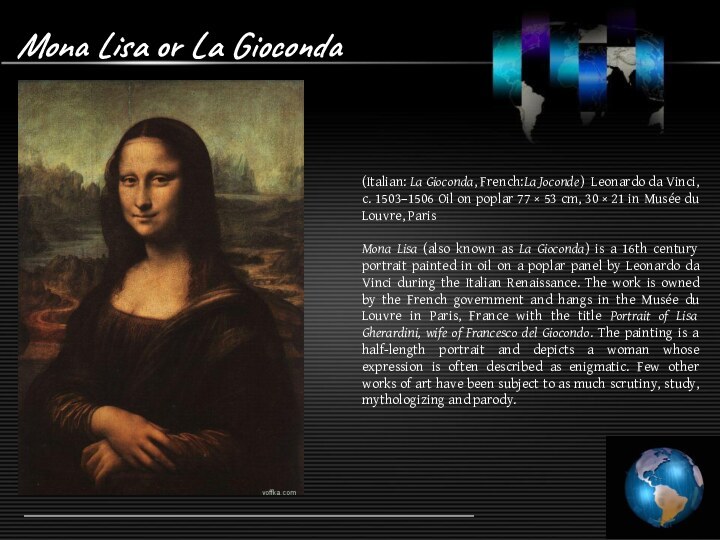- Главная
- Разное
- Бизнес и предпринимательство
- Образование
- Развлечения
- Государство
- Спорт
- Графика
- Культурология
- Еда и кулинария
- Лингвистика
- Религиоведение
- Черчение
- Физкультура
- ИЗО
- Психология
- Социология
- Английский язык
- Астрономия
- Алгебра
- Биология
- География
- Геометрия
- Детские презентации
- Информатика
- История
- Литература
- Маркетинг
- Математика
- Медицина
- Менеджмент
- Музыка
- МХК
- Немецкий язык
- ОБЖ
- Обществознание
- Окружающий мир
- Педагогика
- Русский язык
- Технология
- Физика
- Философия
- Химия
- Шаблоны, картинки для презентаций
- Экология
- Экономика
- Юриспруденция
Что такое findslide.org?
FindSlide.org - это сайт презентаций, докладов, шаблонов в формате PowerPoint.
Обратная связь
Email: Нажмите что бы посмотреть
Презентация на тему The most known pictures of Leonardo da Vinci
Содержание
- 2. Annunciationcirca 1472 –1475 Oil on panel 98
- 3. Ginevra de' Benci circa 1476 Oil on
- 4. Lady with an Ermine 1485 Oil on
- 5. Virgin of the Rocks The Virgin of
- 6. Portrait of a Musician 1490 Oil on
- 7. Last supper (1498)—Convent of Sta. Maria
- 8. Mona Lisa or La Gioconda (Italian:
- 9. The Virgin and Child with St Anne
- 10. Bacchus 1510-1515 Oil on walnut panel
- 11. Salai as John the Baptist 1513-1516 Oil
- 12. Скачать презентацию
- 13. Похожие презентации
Annunciationcirca 1472 –1475 Oil on panel 98 × 217 cm The Annunciation (1472–1475) is a painting by Leonardo da Vinci in the Uffizi Gallery in Florence. It depicts the annunciation by the Archangel Gabriel to the












Слайд 2
Annunciation
circa 1472 –1475 Oil on panel 98 ×
217 cm
Leonardo da Vinci in the Uffizi Gallery in Florence. It depicts the annunciation by the Archangel Gabriel to the Virgin Mary that she will conceive Jesus Christ and is set in the enclosed courtyard garden of a Florentine villa. The marble table in front of the Virgin probably quotes the tomb of Piero and Giovanni de' Medici in the Basilica of San Lorenzo, Florence that was sculpted by Verrocchio in this same period. The background shows a Harbour scene that is believed to be at Rome.
Слайд 3
Ginevra de' Benci
circa 1476 Oil on wood 38.8
× 36.7 cm,
15.3 × 14.4 in National Gallery
of Art, Washington, D.C., USA
Ginevra de' Benci (Born 1457) was a lady of the aristocratic class in 15th century Florence, admired for her intelligence by Florentine contemporaries. It is known from three written sources that Leonardo painted a portrait of Ginevra de' Benci in 1474 in commemoration of her marriage to Luigi Niccolini, and the painting's imagery and reverse text support this theme. Directly behind the young lady in the portrait is a juniper tree. The reverse of the portrait is decorated with a juniper sprig encircled by a wreath of laurel and palm and is memorialized by the phrase VIRTUTEM FORMA DECORAT ("Beauty adorns Virtue").
Слайд 4
Lady with an Ermine
1485 Oil on wood panel
54 × 39 cm
Czartoryski Museum, Kraków.
Lady with an
Ermine is a painting by Leonardo da Vinci, around 1489–1490. Its subject is identified with reasonable security as Cecilia Gallerani, the mistress of Lodovico Sforza, "Ludovico il Moro", Duke of Milan. Despite sustaining much damage – the surface is much rubbed, the background was lightly over painted with unmodulated black, the upper left corner has been broken and repaired, a transparent veil on the model's head was turned into an extravagant hairdo and several fingers were grossly retouched – it is nonetheless in better condition than many of Leonardo's other paintings.
Слайд 5
Virgin of the Rocks
The Virgin of the Rocks
(sometimes the Madonna of the Rocks) is the usual
title used for both of two different paintings with almost identical compositions, which are at least largely by Leonardo da Vinci. They are in the Louvre, Paris, and the National Gallery, London.1483-1486 Oil on panel (transferred to canvas) 199 × 122 cm, 78.3 × 48.0 in Louvre, Paris.
This version is in the Louvre, painted around 1483-1486, or earlier. Most authorities agree that the work is very largely by Leonardo, and is the earlier of the two works. The fine brush work and use of chiaroscuro, or contrast between light and dark, are considered characteristic of many of Leonardo's works. It is about 8cm taller than the London version. The first record of this picture is in 1625, when it was in the French royal collection. The Louvre version is featured in
The Da Vinci Code although art historians are dismissive of the "hidden meaning" there ascribed to it. An almost identical painting is in the National Gallery, London, ascribed to Leonardo da Vinci, probably before 1508. After passing through various collections, it was bought by the National Gallery in 1880.
Слайд 6
Portrait of a Musician
1490 Oil on wood panel
45 × 32 cm
Pinacoteca Ambrosiana, Milan.
Portrait of a
Musician is an oil on wood painting often attributed to Leonardo Da Vinci by some scholars. It was probably painted in 1490. The man in the painting was at one time thought to be Franchino Gaffurio, who was the maestro di cappella of the Milanese Cathedral. Although some believe it to be a portrait of Gaffurio, others think the man is anonymous. The piece of paper he holds is at least one part of a musical score; it has notes written on it. The painting was greatly restored and repainted, and Leonardo probably left the portrait unfinished but close to completion.
Слайд 7
Last supper
(1498)—Convent of Sta. Maria delle Grazie,
Milan, Italy
The painting measures 460 × 880 centimeters (15 feet
× 29 ft) The theme was a traditional one for refectories, but Leonardo's interpretation gave it much greater realism and depth. The lunettes above the main painting, formed by the triple arched ceiling of the refectory, are painted with Sforza coats-of-arms. The Last Supper specifically portrays the reaction given by each apostle when Jesus said one of them would betray him. All twelve apostles have different reactions to the news, with various degrees of anger and shock.
Слайд 8
Mona Lisa or La Gioconda
(Italian: La Gioconda,
French:La Joconde) Leonardo da Vinci, c. 1503–1506 Oil on
poplar 77 × 53 cm, 30 × 21 in Musée du Louvre, ParisMona Lisa (also known as La Gioconda) is a 16th century portrait painted in oil on a poplar panel by Leonardo da Vinci during the Italian Renaissance. The work is owned by the French government and hangs in the Musée du Louvre in Paris, France with the title Portrait of Lisa Gherardini, wife of Francesco del Giocondo. The painting is a half-length portrait and depicts a woman whose expression is often described as enigmatic. Few other works of art have been subject to as much scrutiny, study, mythologizing and parody.
Слайд 9
The Virgin and Child with St Anne
circa
1508 Oil on wood 168 × 112 cm Louvre,
ParisThe Virgin and Child with St Anne is an oil painting by Leonardo da Vinci depicting St. Anne, her daughter the Virgin Mary and the infant Jesus. Christ is shown grappling with a sacrificial lamb symbolizing his Passion whilst the Virgin tries to restrain him. The painting was commissioned as the high altarpiece for the Church of Santissima Annunziata in Florence and its theme had long preoccupied Leonardo. In 1498. An earlier cartoon exhibited in Santissima Annunziata in 1501 is now lost.
Слайд 10
Bacchus
1510-1515 Oil on walnut panel transferred to
canvas 177 × 115 cm Louvre, Paris
The Leonardesque painting
of Bacchus, formerly a Saint John the Baptist. The drawing Sidney J. Freedberg assigns to Leonardo's second Milan period. He over painting transformed the image of St. John into one of a lusty pagan, by converting the long-handled cross-like staff to a Bacchus thyrsus and adding an ivy wreath. The fur and wreath in the painting are the legacy of John the Baptist, while the fruit and laurel wreath relate the figure to Bacchus, the Roman god of wine and intoxication.
Слайд 11
Salai as John the Baptist
1513-1516 Oil on walnut
wood 69 × 57 cm, 27.2 × 22.4 in
Louvre, ParisCompleted from 1513 to 1516, when the High Renaissance was metamorphosing into Mannerism, it is believed to be his last painting. The original size of the work was 69x57 cm. It is now housed at the Musée du Louvre in Paris, France. The pointing gesture of St. John toward the heavens suggests the importance of salvation through baptism that John the Baptist represents. The work is often quoted by later painters, especially those in the late Renaissance and Mannerist schools. The inclusion of a gesture similar to John's would increase the importance of a work with a religious conceit.





























